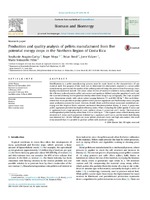Mostrar el registro sencillo del ítem
Production and quality analysis of pellets manufactured from five potential energy crops in the Northern Region of Costa Rica
| dc.contributor.author | Aragón-Garita, Stephanie | |
| dc.contributor.author | Moya-Roque, Róger | |
| dc.contributor.author | Bond, Brian | |
| dc.contributor.author | Valaert, Jorre | |
| dc.contributor.author | Tomazello-Filho, Mario | |
| dc.date.accessioned | 2018-07-24T17:54:59Z | |
| dc.date.available | 2018-07-24T17:54:59Z | |
| dc.date.issued | 2016 | |
| dc.identifier | https://www.sciencedirect.com/science/article/pii/S0961953416300277 | es |
| dc.identifier.citation | Aragón-Garita, S., Moya-Roque, R., Bond, B., Valaert, J., & Tomazello-Filho, M. (2016). Production and quality analysis of pellets manufactured from five potential energy crops in the Northern Region of Costa Rica. Biomass and Bioenergy 87, 84-95. | es |
| dc.identifier.uri | https://hdl.handle.net/2238/9832 | |
| dc.description | Artículo científico | es |
| dc.description.abstract | Modifications to a pellet manufacturing process must be made based on the characteristics of raw material used. The purpose of this work was to determine the alternations required to a wood pellet manufacturing process and the quality of the pellets produced using this process from five energy crops. Quality measurements include: the caloric value, the loss of moisture content in each production stage, the efficiency index of particle-pellet, ash content and quality as defined using the quantity of cracks and the transversal density and longitudinal density determined using X-ray radiography. The crops analyzed were rhizomatous plants, with caloric values ranging between 17.1 and 20.3 MJ kg 1. This work determined that it was possible to produce pellets with Gynerium sagittatum and Phyllostachys aurea using the same production process for wood; however, Arundo donax and Pennisetum purpureum needed pre-airdrying and the Sorghum bicolor required mechanical dewatering before drying. A. donax, P. purpureum and G. sagittatum provided the highest efficiency index. When evaluating the pellet quality P. aurea and G. sagittatum hard a large quantity of cracks, unlike A. donax, P. purpureum and S. bicolor. The transversal and longitudinal pellet density varied from 1129 to 1294 kg m 3. The highest values of bulk density were obtained in A. donax and P. purpureum, followed by G. sagittatum and P. aurea, and the lowest bulk density was obtained in S. bicolor. Althogh out, some species produced cracks and high ash content, this work demonstrated that it is possible to produce pellets with moderate quality. | es |
| dc.language.iso | eng | es |
| dc.publisher | Biomass and Bioenergy | es |
| dc.relation.hasversion | 10.1016/j.biombioe.2016.02.006 | es |
| dc.rights | acceso abierto | es |
| dc.source | Biomass and Bioenergy | es |
| dc.subject | Biomasa | es |
| dc.subject | Residuos | es |
| dc.subject | Cultivos | es |
| dc.subject | Rotación de cultivos | es |
| dc.subject | Materia prima | es |
| dc.subject | Research Subject Categories::FORESTRY, AGRICULTURAL SCIENCES and LANDSCAPE PLANNING::Product science::Wood fibre and forest products | es |
| dc.title | Production and quality analysis of pellets manufactured from five potential energy crops in the Northern Region of Costa Rica | es |
| dc.type | Artículo original | es |
Ficheros en el ítem
Este ítem aparece en la(s) siguiente(s) colección(ones)
-
Artículos [37]


